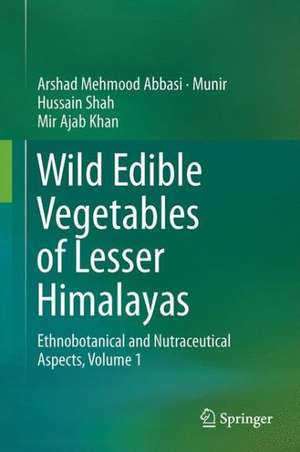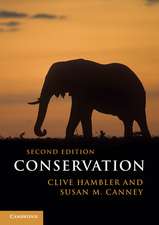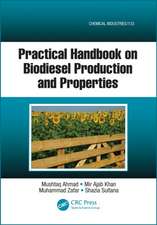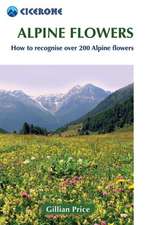Wild Edible Vegetables of Lesser Himalayas: Ethnobotanical and Nutraceutical Aspects, Volume 1
Autor Arshad Mehmood Abbasi, Munir Hussain Shah, Mir Ajab Khanen Limba Engleză Hardback – 4 noi 2014
Wild Edible Vegetables of Lesser Himalayas is a concise and handy guide for scientists, scholars, and students interested in the study of agriculture, food science, nutraceutical science, bioscience, biodiversity, applied ethnobotany, ethnoecology, and ecology.
| Toate formatele și edițiile | Preț | Express |
|---|---|---|
| Paperback (1) | 950.52 lei 3-5 săpt. | |
| Springer International Publishing – 23 aug 2016 | 950.52 lei 3-5 săpt. | |
| Hardback (1) | 954.62 lei 6-8 săpt. | |
| Springer International Publishing – 4 noi 2014 | 954.62 lei 6-8 săpt. |
Preț: 954.62 lei
Preț vechi: 1164.17 lei
-18% Nou
Puncte Express: 1432
Preț estimativ în valută:
182.67€ • 191.20$ • 152.04£
182.67€ • 191.20$ • 152.04£
Carte tipărită la comandă
Livrare economică 31 martie-14 aprilie
Preluare comenzi: 021 569.72.76
Specificații
ISBN-13: 9783319095424
ISBN-10: 3319095420
Pagini: 285
Ilustrații: XVII, 360 p. 251 illus. in color.
Dimensiuni: 155 x 235 x 20 mm
Greutate: 0.71 kg
Ediția:2015
Editura: Springer International Publishing
Colecția Springer
Locul publicării:Cham, Switzerland
ISBN-10: 3319095420
Pagini: 285
Ilustrații: XVII, 360 p. 251 illus. in color.
Dimensiuni: 155 x 235 x 20 mm
Greutate: 0.71 kg
Ediția:2015
Editura: Springer International Publishing
Colecția Springer
Locul publicării:Cham, Switzerland
Public țintă
ResearchCuprins
Pakistan and Pakistani Himalayas.- Ethnobotany and Ethnomedicine.- Phytochemicals and Nutraceuticals.- Ethnobotanical Aspects of Wild Edible Vegetables.- Nutritional Contents of Wild Edible Vegetables.- Metal Levels in Wile Edible Vegetables.- Phytochemical Contents of Wild Edible Vegetables.- Antioxidant Properties of Wild Edible Vegetables.
Recenzii
“This book by Abbasi et al. is a nicely documented work of wild edible vegetables and indeed a rich source of information for development of commercial or cultivated foods and perhaps drugs. This beautiful volume contains a number of striking photographs, graphs and charts that make the information more tangible. … the book would certainly be a useful resource to anyone who researches the Himalayas, ethnobotany, wild edible plants and phytochemicals and nutraceuticals.” (Ripu Kunwar, Economic Botany, Vol. 71 (1), 2017)
Notă biografică
1. Arshad Mehmood Abbasi (Ph.D.)
Arshad Mehmood Abbasi is an Assistant Professor of Environmental Sciences at COMSATS Institute of Information Technology, in Abbottabad, Pakistan since 2013. He received his PhD in Plant Sciences with specialization in Ethnobotanical and Nutraceutical aspects of wild edible fruits and vegetables of Lesser Himalayas, Pakistan from Quaid-i-Azam University in Islamabad, Pakistan in 2013. His primary research and professional activities have been in Ethnobotany, Ethnomedicines, Medicinal Plants, Biodiversity, Forest Food Resources, Phytochemistry, Nutraceuticals and Functional Foods. He is the editor of the Journal of Ethnobiology and Ethnomedicines and also authored the book entitled, Medicinal Plant Biodiversity of Lesser Himalayas-Pakistan published by Springer, USA in 2012. He has been the recipient of the Outstanding Research Award in the "Best Research Paper" category for the years 2010-2011, from the Higher Education Commission of Pakistan.
2. Muhnir H. Shah (Ph.D.)
Munir H. Shah is an Associate Professor of Chemistry at Quaid-i-Azam University in Islamabad, Pakistan since 2004, and also received his PhD in Analytical/Environmental Chemistry in 2007. His primary research and professional activities have been in Hydrogeochemistry, Atmospheric Chemistry, Clinical Chemistry, Toxicological Chemistry and Chemometrics and has published several research articles on these topics. He was the recipient of the "Young Scientist in Chemistry" award, from the Third World Academy of Sciences in 2010 and the "Best Young Research Scholar" award, from the Higher Education Commission of Pakistan in 2011.
3. Mir Ajab Khan (Ph.D.)
Mir Ajab Khan is a Professor of Plant Sciences at Quaid-i-Azam University in Islamabad, Pakistan. He received his PhD in Biosystematics from Leicester University, England in 1984. His research and professional activities have been in Biosystematics, Chemotaxonomy, Taxonomy, Palynology, Anatomy, Medicinal Plants, Biofuels and Oil Yielding Plants, Ethnobotany, and Plant Biodiversity. He has published more than 300 research articles in journals of international repute in these areas and also authored a number of national and international books. He is also the recipient of a number of outstanding achievement and research awards by the Higher Education Commission of Pakistan.
Arshad Mehmood Abbasi is an Assistant Professor of Environmental Sciences at COMSATS Institute of Information Technology, in Abbottabad, Pakistan since 2013. He received his PhD in Plant Sciences with specialization in Ethnobotanical and Nutraceutical aspects of wild edible fruits and vegetables of Lesser Himalayas, Pakistan from Quaid-i-Azam University in Islamabad, Pakistan in 2013. His primary research and professional activities have been in Ethnobotany, Ethnomedicines, Medicinal Plants, Biodiversity, Forest Food Resources, Phytochemistry, Nutraceuticals and Functional Foods. He is the editor of the Journal of Ethnobiology and Ethnomedicines and also authored the book entitled, Medicinal Plant Biodiversity of Lesser Himalayas-Pakistan published by Springer, USA in 2012. He has been the recipient of the Outstanding Research Award in the "Best Research Paper" category for the years 2010-2011, from the Higher Education Commission of Pakistan.
2. Muhnir H. Shah (Ph.D.)
Munir H. Shah is an Associate Professor of Chemistry at Quaid-i-Azam University in Islamabad, Pakistan since 2004, and also received his PhD in Analytical/Environmental Chemistry in 2007. His primary research and professional activities have been in Hydrogeochemistry, Atmospheric Chemistry, Clinical Chemistry, Toxicological Chemistry and Chemometrics and has published several research articles on these topics. He was the recipient of the "Young Scientist in Chemistry" award, from the Third World Academy of Sciences in 2010 and the "Best Young Research Scholar" award, from the Higher Education Commission of Pakistan in 2011.
3. Mir Ajab Khan (Ph.D.)
Mir Ajab Khan is a Professor of Plant Sciences at Quaid-i-Azam University in Islamabad, Pakistan. He received his PhD in Biosystematics from Leicester University, England in 1984. His research and professional activities have been in Biosystematics, Chemotaxonomy, Taxonomy, Palynology, Anatomy, Medicinal Plants, Biofuels and Oil Yielding Plants, Ethnobotany, and Plant Biodiversity. He has published more than 300 research articles in journals of international repute in these areas and also authored a number of national and international books. He is also the recipient of a number of outstanding achievement and research awards by the Higher Education Commission of Pakistan.
Textul de pe ultima copertă
Our intention with this book was to present the reader with the most accurate, significant, and up-to-date background and knowledge in the areas of ethnomedicinal and nutraceutical vegetation for the Lesser Himalayas in a comprehensive text. Wild Edible Vegetables of Lesser Himalayas provides a complete review of over 50 important plants of this region and details each species including photographs, botanical name, local name, family, flowering and fruiting period, status and habitat, parts used, distribution, ethnobotanical uses, cultural aspects, medicinal uses, and nutraceutical aspects. Medicinal uses include mode of preparation, method of application and diseases studied; cultural aspects and index; nutraceutical data provides analysis of fats, proteins, fibers, carbohydrates, ash, moisture content, dry matter, and energy value; elemental analysis includes various essential and toxic metals; phytochemical screening includes total phenolics, flavonoids, flavonols and ascorbic acid, and antioxidant potential in terms of DPPH scavenging activity, hydroxyl radical scavenging activity, H2O2 scavenging activity, Fe2+ chelating activity, ferric reducing antioxidant power, and phosphomolybdenum assay for each species.
Wild Edible Vegetables of Lesser Himalayas is a concise and handy guide for scientists, scholars, and students interested in the study of agriculture, food science, nutraceutical science, bioscience, biodiversity, applied ethnobotany, ethnoecology, and ecology.
Wild Edible Vegetables of Lesser Himalayas is a concise and handy guide for scientists, scholars, and students interested in the study of agriculture, food science, nutraceutical science, bioscience, biodiversity, applied ethnobotany, ethnoecology, and ecology.
Caracteristici
Previously unpublished data on 50 wild edible vegetables Medicinal and non-medicinal values of these plants Food value including nutritional, heavy metal concentrations, antioxidant activity and energy values Nutraceutical data provides analysis of fats, proteins, fibers, carbohydrates, ash, moisture content, and dry matter Socio-economic and cultural significance of wild plants










